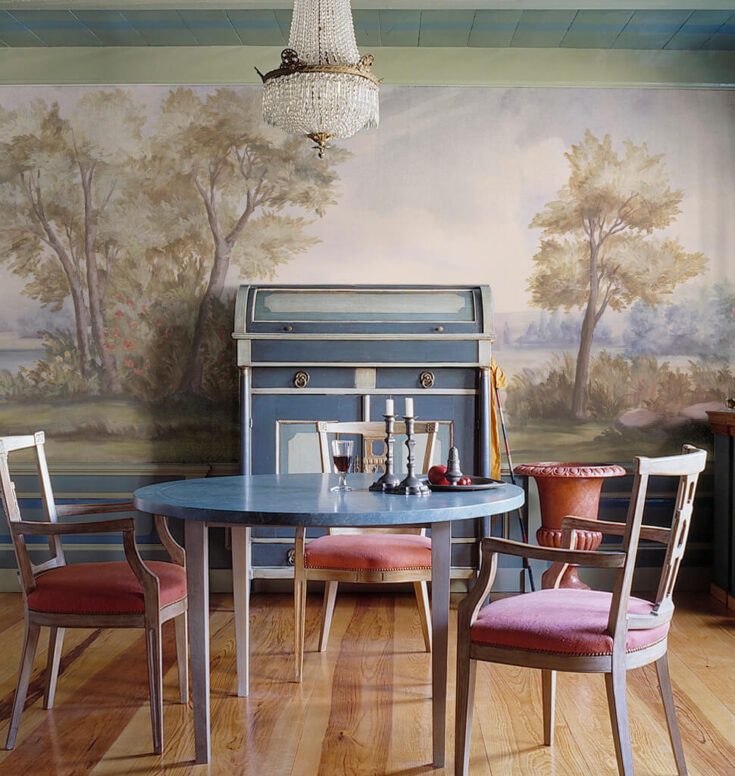
How to Choose
A TIMELESS MURAL
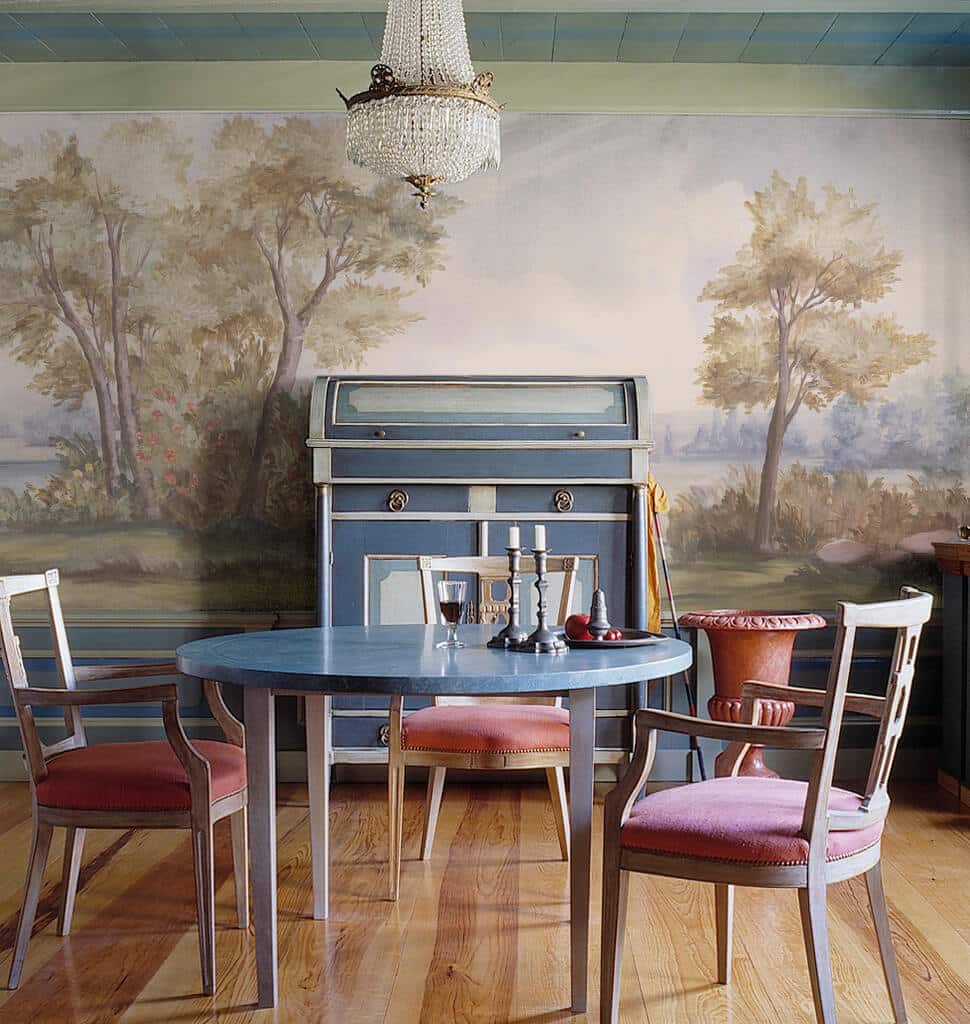
Sometimes people worry, “Won’t murals go out of style?” I’m always tempted to answer, “Not until people go out of style!”
Though murals have definitely been having a moment on Pinterest and Instagram, murals themselves have always been “in style.”
The urge to decorate our walls seems hard-wired into humans. We started painting wall murals at least 40,000 years ago on cave walls in modern-day France and Indonesia. And we kept on going, painting murals on the walls of Pompeii, the Indian caves of Ajanta, the ceiling of the Sistine Chapel, and right on to the present day.
Perhaps a better question is, “Which of the murals we see will stand the test of time, since people have loved them and will continue to love them?” Murals that reflect the long, rich tradition of mural history. The most timeless murals are those that reference, in both technique and subject matter, the best-loved murals of the last few centuries.
Here are the:

3 Types of Murals That
Never go out of style
- Chinoiserie and Asian Scenics
- Elaborate Woodblock Printed Landscapes
- Trompe l’Oeil and Landscape Murals by Classically Trained Artists
Each of these mural styles have deep roots in the mural painting tradition, the scope of which may be well beyond the limits of a blog post. But understanding at least a bit of it will give you the background you need to confidently choose quality. So here’s a capsule summary:
Chinoiserie and Asian Scenics
The recent bubble of popularity for Chinoiserie might tempt the uninitiated to imagine this is a new or temporary craze. Yet it’s actually been popular among the design savvy for four centuries, with no signs of losing favor.
The East-meets-West design love story of Chinoiserie starts in Europe in the late 1600s. Europeans had already been producing block-printed or stenciled wallpapers. Some of these imitated carved wood paneling, or woven tapestries, others were in repeat Baroque patterns. (An expert and fascinating history of the art of wallpapers can be found in The Papered Wall, edited by Leslie Hoskins.)
Because early paper-making and printing equipment was limited in size, the very first of such wallpapers were often printed in small squares rather than on long rolls as we do today. In fact, if you’ve noticed this “many small squares of paper” appearance on today’s luxury wallpapers, it’s a quiet insider nod to this quirk of manufacturing history.
Increased trade with what was then called “The Orient” meant scenic papers and hand-painted decorative silks were imported from China. Asian art was a revelation for the Europeans. Not only were the qualities of the underlying materials far superior to those of European manufacturers, but the artwork itself – delicate, graceful, and faithful to natural forms – was new and marvelous.
Two styles were particularly admired. The first style, the “Bird-and-Flowers” motif, includes meandering branches of bamboo, peonies, and slender, flowering trees arranged in a pleasingly irregular, non-repeating pattern. These tree-like forms were then accented with birds and butterflies. The overall effect is more of a flat decorative pattern than a deep, three-dimensional landscape.
The second style depicted intricate landscapes of mountains, waters, trees, pagodas, and tiny, graceful figures in traditional Chinese costumes. The perspective used on such scenery takes a different approach to that used in Western art. Rather than limit themselves to what we’d see from a certain vantage point, the artists used a supra-realist technique, showing everything they know is there. Likewise, dark shadows are absent, and the realistic modeling of forms is abandoned for a calm, consistent, overall radiance of light.
Though utterly lacking the Chinese skill in rendering such scenes, the European manufacturers of the day quickly created their own interpretations of the style, which came to be called Chinoiserie. “Chinoiserie” is French for “in the manner of the Chinese.” A close phonetic spelling might be something like “schin-WAH-zeh-ree,” but here’s a link to the actual French.
Chinoiserie goods were snapped up by the nobility and spread like wildfire through the elite of Europe. According to The Papered Wall, as the designs traveled and were interpreted and re-interpreted, they picked up regional European decorative influences. They were also adapted to the already popular tree-like forms of the “Tree of Life” or “Palampore” pattern chintzes that England imported from the East India Company.
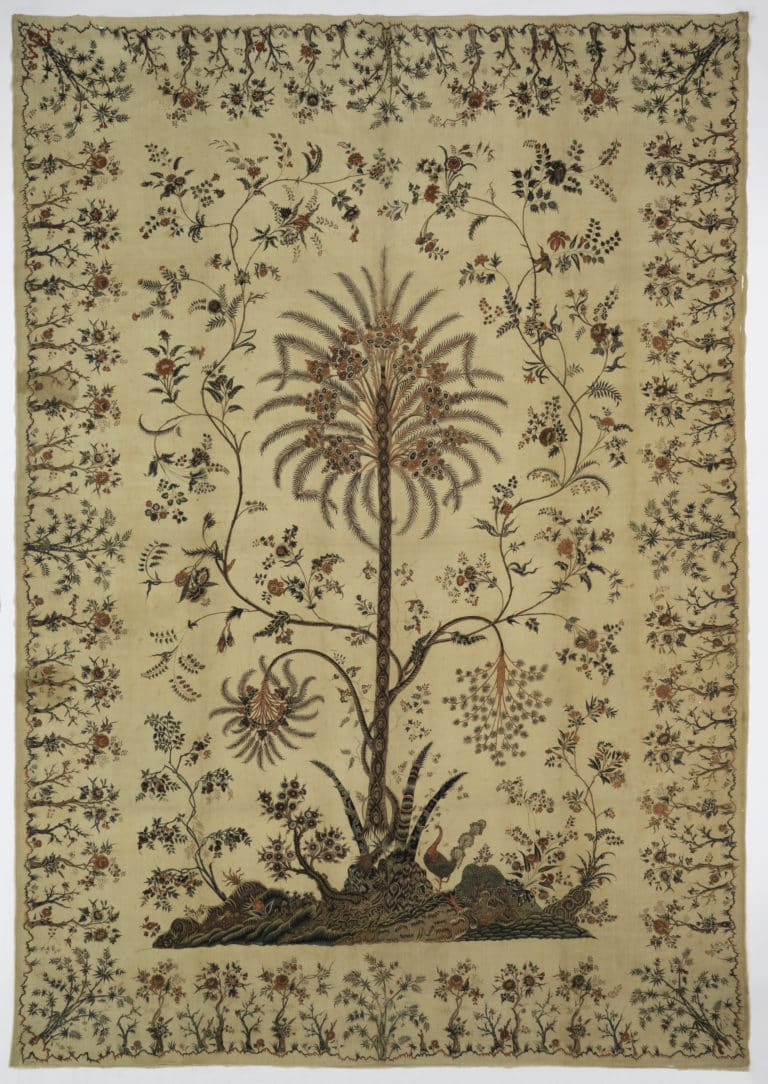
India was the largest exporter of fabrics the word has ever known, and their painted, resist-dyed, and later, block-printed goods had a great influence on European designs.
So what we call Chinoiserie today was truly a unique mixture of Eastern and Western design, a melting pot of stylistic influences. Often the admixture bore little resemblance to the Chinese originals that had inspired it. In remote regions, artists had few actual examples to study, and their attempts at imitation led to wildly creative liberties, like improbable, gigantic plants with fantastical birds in their branches. Still, some of these naïve examples have their own exuberant, regional charm.
For example, curators of Drottingholm Castle in Sweden were kind enough to let me take a private peek at this Chinoiserie-inspired mural in the back rooms of King Gustaf’s theatre. It’s an incredibly light-hearted and charming mix of formal Chinoiserie and Swedish folk art.
The Chinoiserie craze hit the American colonies shortly after their introduction to Europe. Sea-faring captains of New England were fond of bringing home fine wallpaper Chinoisierie to their seaport mansions. The still-abiding Puritan passion, among Boston Blue-boods, for thrift and honoring one’s own ancestors, has allowed several of these papers to survive, intact, to the present day.
I’ve been privileged to glimpse a few originals in East Coast mansions of the late 1700s and early 1800s, and have often been asked to re-create them where they were missing. Here, for example, was a playful take on the theme created for the Commander’s Mansion in Watertown, MA, during a Junior League Showhouse:
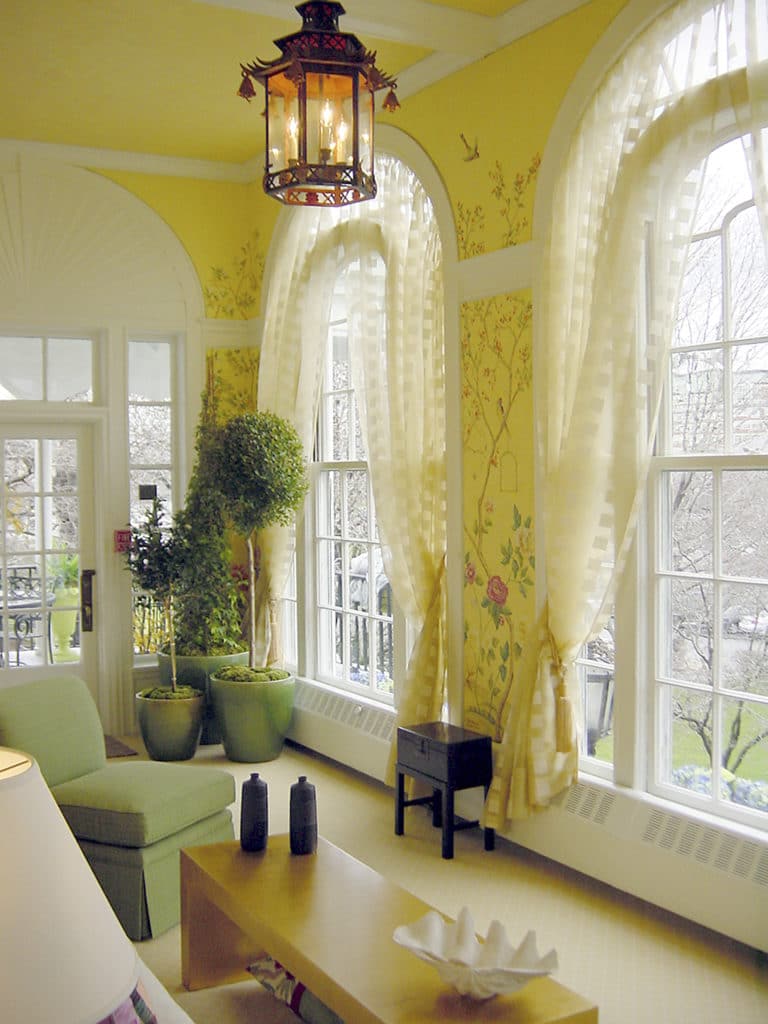
If this isn’t enough to convince you of Chinoiserie’s enduring charm, consider the example of the Chinoiserie room at Albany, decorated in 1975 by Pauline, Baroness de Rothschild with the iconic designer John Fowler.
The Baroness, an international taste-maker, chose an eighteenth-century Chinoiserie paper for a bedroom, as seen in a Pinterest-perennial-favorite image.
The 1977 article on the apartment inspired a slew of imitations among interior designers. Then another burst of interest in 2017, when de Gournay released a modern wallpaper inspired by the Rothschild version. Which, in turn, inspired Gucci’s recent Chinoiserie craze.
There you have it – one particular pale green wallpaper, over 30 years of design aficionado frenzy. Given that Europe has loved Chinoiserie for 400 years and the Americas have for 300, it’s always a solid pick for the homeowner or designer searching for a timeless mural.
3 Insider Tips for Recognizing a Quality Chinoiserie
- Study historic examples still held in museums, or sold by the luxury companies Gracie, de Gournay, and Fromental.
- Look for murals done by actual Chinese artists. As a Western-trained muralist, I’m just going to come out and say it: no Western artist is going to do better than a Chinese master artist at creating Chinoiserie. We haven’t been trained for years in the same kinds of brushstrokes. We haven’t been seeping our eyeballs for decades in the same visual culture. Luxury companies like de Gournay hire Chinese artists. If you’re brave enough to make an international purchase, a few Chinese companies are also selling directly to the US and European markets (see below). Buy the real thing, not a poor imitation.
- Look for murals done on the correct substrate, in the correct scale. Low-end mural companies hoping to make a quick buck will either buy a tiny piece of real Chinoiserie and BLOW IT UP TO A HUGE SIZE so it’s all blurry, or get the real stuff, and copy it, and print it badly on cheap commercial vinyl. If you can’t afford hand-painted, look for a GOOD printed reproduction. Request samples. Look for real paper and real canvas, not shiny fakes or peel-and-stick.
Where to Buy:
High-end, hand-painted (to-the-trade only):
Archival and fine art quality, printed:
High-end, hand-painted, direct from Chinese makers:
Mid-range, printed:
Cheap and stylish, printed:
European-style Woodblock Murals
The designer and homeowner in search of a timeless, formal, and intricate mural landscape would do well to choose a mural in the “woodblock” printed style, which has been popular for nearly 300 years.
In the late 1700s, the technique of woodblock printing was raised to a high art form. Each portion of a mural landscape, such as a single tree branch, would be carved into an individual block of wood. The blocks were then daubed with colored inks and pressed carefully onto paper. The best papers might use dozens of colors and hundreds of blocks, overlaid to create very complex designs.
The French wallpaper company Zuber, in business since 1787 and still using many of the original blocks, has a wonderful short video showcasing the technique.
The woodblock-printed wallpaper, both past and present, often employs stylistic devices like draperies, columns, lattice, statuary, and urns to give paperhangers a convenient way to break up the continuous scenery and join sections of the murals together. The murals tend to be quite formal in tone. This stems partially from the subject matter, and partially from the hint of stiffness created by using a mechanical means of reproduction.
Because each area is delineated by a separate wood block, small areas of flat color are visible from a close distance, sort of like the old “paint by the numbers” kits that children use. Here’s a close-up example from a wallpaper in the collection of the Cooper-Hewitt Museum:
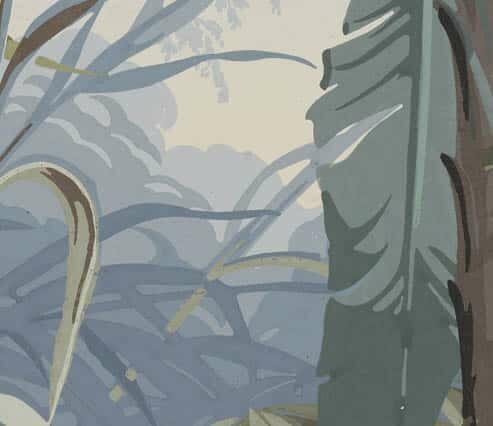
From a little distance, the effect has great richness and surprising depth. It’s an extremely clever and effective way to mechanize the act of mural painting.

Similar techniques are used in theatrical painting to quickly create a sense of realism without the need for painstaking gradations of shading. You can see an example in the foreground of this photo of a set being painted. Notice how the leaves are applied as a solid light green, and the artist is working from discrete buckets of color, rather than mixing on the palette as a fine artist might.
The blossoming industry of French panoramic murals coincided with the exploration of—and fascination with—what Europeans considered to be exotic landscapes and primitive cultures, such as life in India, the Tropics, or the former American colonies.
In 1806, Joseph Dufour et Cie created the largest panoramic mural of the time: 20 panels depicting the recent travels of Captain Cook. People purchased tickets to view these epic panoramics in large circular rooms, as they were revered as a form of artful entertainment.
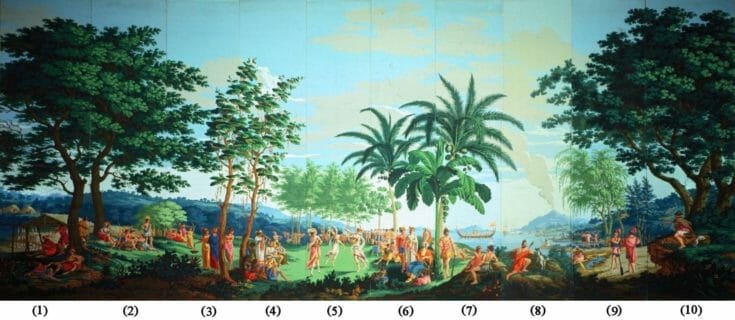
I was lucky enough to catch a special exhibition at the Musée des Arts Décoratifs, Paris of scenic wallpapers from many of the old French companies like Jules Desfosse, and Dufour et Leroy, and Zuber et Cie. (Zuber still produces mural wallpaper!) The image below shows the complexity that these designs could contain.
Perhaps surprisingly, modern interior designers have paired such elaborate, block-printed murals to good effect with spare, minimalist furnishings. The contrast really shows off the strong points of each, provided the furniture is of excellent form and quality. In fact, the enduring popularity and use of these eighteenth- and nineteenth-century murals is attested to by the fact that the originals, carefully scraped from mansion walls and salvaged, are still a hot commodity. Such vintage murals are sold today by companies like A. L. Diament and regularly turn up on auction websites like Sotheby’s and 1stdibs.
Where to Buy:
Luxury woodblock murals:
- Zuber
- Vintage murals from A. L. Diament
- Vintage murals from 1stdibs
Upper mid-range woodblock murals:
- Beauchamp
- Holly Alderman (digital Dufour reproduction)
- Muralmaps (digital Dufour reproduction)
Luxury, non-mural woodblock prints


